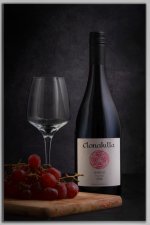One of the hardest things in photography i've found, is making the message my shot conveys, carry through to the image, and be the message that the viewer carries away... The key is often to consider ALL the messages that the image can convey, to anticipate the positive and negative spins that people will put on the shot - because, however much we may just say "oh, its just a picture of a nice bottle of wine, in a suitably atmospheric surrounding" (not dismissing the OP's original image as being just that BTW - its definitely more than that) - EVERYONE who looks at a photo makes their own assessments and writes their own mental story about what they see. They MAY not actually realise that they are doing, but they do. That's why visual media are powerful tools in the right (or, some may argue, even more so the wrong) hands. As a photographer, who did quite a bit of advertising / product shots - though nowhere near Garry's level or depth of experience - I worked with art directors, with marketing people, and lots of "arty-farty" types that weren't interested in the slightest in how I got the photo - all they wanted was that it "spoke" to the message of the job brief. I was there to take the picture they painted in words, and turn it into a 10"x8" transparency.
While I haven't done any of that stuff for a couple of decades or more, that kind of approach still stuck with me, and when I so very occasionally get the camera out these days, for anything of an indoor setup shot, I may have a "centerpiece" of the image that I'm wanting to portray - but - my first recourse is to decide what I want to say about it, and often I'll even write myself a little "back story" for the image, and sketch out the image as if it was a frame from a "storyboard" from that back story being filmed. The key being to try and tell that whole back story in a single frame. That way I've as good a chance as possible to actually get my "message" over. Not saying its right, or its the only way to work, but it certainly improved my outputs quality level (from IMO pretty poor, to half acceptable - i'm very often my own harshest critic)
Single glass very much speaks to loneliness, either from loss of partners/friends, or, for example going back to the old masters Vanitas artworks - the isolation that comes with wealth - look back into that school of art, and its very seldom that, even in the massively overloaded tables displaying ostentatious wealth, that the table would be "set" for more than one consumer... like most Vanitas works, there was an element of the artist "thumbing their nose" at the Rich family comissioning their work - saying "you may be rich in posessions, but poor in company and companionship". It's actually a very effective way of setting a mood -
a single glass can definitely speak volumes...







